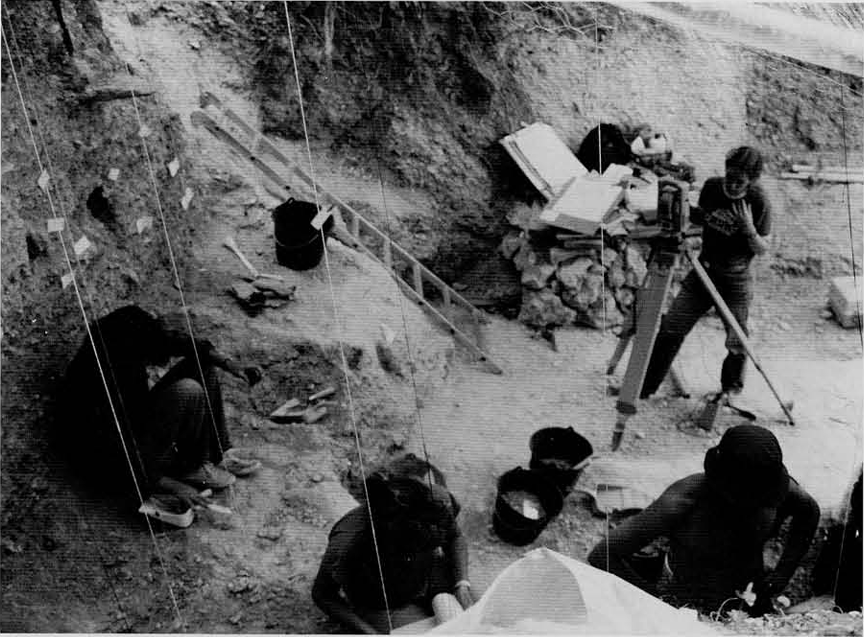
The Paleolithic, or “Old Stone Age,” is a fascinating period of prehistory for anyone interested in human origins and evolution. It encompasses the crude beginnings of stone tool manufacture through the development of highly skilled technologies in both stone and bone. It represents the time during which our ancestors evolved, both physically and behaviorally, from apelike beings with limited technological and cultural complexity to fully modern Homo sapiens with a tremendous variety of social, linguistic, and technological behaviors. It was also during the Paleolithic—and the period of tremendous climatic fluctuations known as the Ice Ages, or Pleistocene epoch—that the first human pioneers migrated from Africa to inhabit virtually all regions of the Old World. To understand how and why humans evolved and were able to adapt to such a myriad of environments is the goal of Paleolithic archaeology, The Paleolithic began about 2 million years ago in Africa with the first appearance of stone tools, and lasted until 10,000 years ago. It ended well before the invention of metallurgy and even before the widespread use of ground stone tools or pottery vessels (although baked clay figurines do occur in some late Paleolithic contexts). There were no forms of transportation except human locomotion. With no domesticated plants or animals, Paleolithic people survived solely on what was available in the environment. They lived in small mobile bands and did not settle permanently in any one location. This way of life implies social relations that are very different from our own. As an archaeologist once pointed out, a modern American encounters more strangers during one trip to a shopping mall than a Paleolithic person encountered in a lifetime. Even such basic human behavior as the creation of art and personal adornment does not seem to have appeared until just before the end of the Paleolithic, and the same may be true of religion. Writing was not invented until long after the Paleolithic.
Life was quite different during the Paleolithic than it is today, and the task of Paleolithic archaeologists is to reconstruct it as accurately as possible. The evidence we have for Paleolithic behavior consists mostly of chipped stone tools (lithics) and animal bones, that is, only those things that will last for such a long time. Unfortunately, these objects represent only a small portion of the artifacts that were made and used by these people, and as we will see below, they pose tremendous problems of interpretation as well.
Finding Paleolithic remains is difficult, since most sites are now coy eared by several meters of sediment deposited over the millennia. Often those remains that are found are severely disturbed, either by geological or other natural processes or by human activity. With such fragmentary and often biased data, it is a major challenge for Paleolithic archaeologists to determine how people lived and adapted to their surroundings.
In the next few pages I will outline some of what we think we know about the Paleolithic of Europe. In addition to presenting these “facts,” which are really not facts at all but opinions, I will also try to explain how these opinions were reached. Most of the subjects I will deal with are surrounded by controversy, and I will try to give some idea of the major points of disagreement. The best way to proceed is to first present a sketch of the European Paleolithic sequence, followed by more in-depth reviews of particular topics of Paleolithic lifeways.
An Overview of the European Paleolithic
The Paleolithic is divided into three stages (Fig. 2). From oldest to youngest these are the Lower, Middle, and Upper Paleolithic. Originally, each of these stages was defined on the basis of certain major patterns of stone tool manufacture. The Lower Paleolithic (which began in Africa about 2 million years ago and in Europe between 500,000 and 750,000 years ago with the first migration of hominids into temperate zones) is often characterized by the production of handaxes or bifaces (Fig. 3). These are objects made by chipping a whole nodule of flint or certain other stones to produce an often pointed form, worked on two surfaces, with sharp cutting edges. Some of the flakes produced as byproducts of handaxe manufacture were in turn modified and shaped, also by chipping, to produce what are called flake tools, of which there are many types.
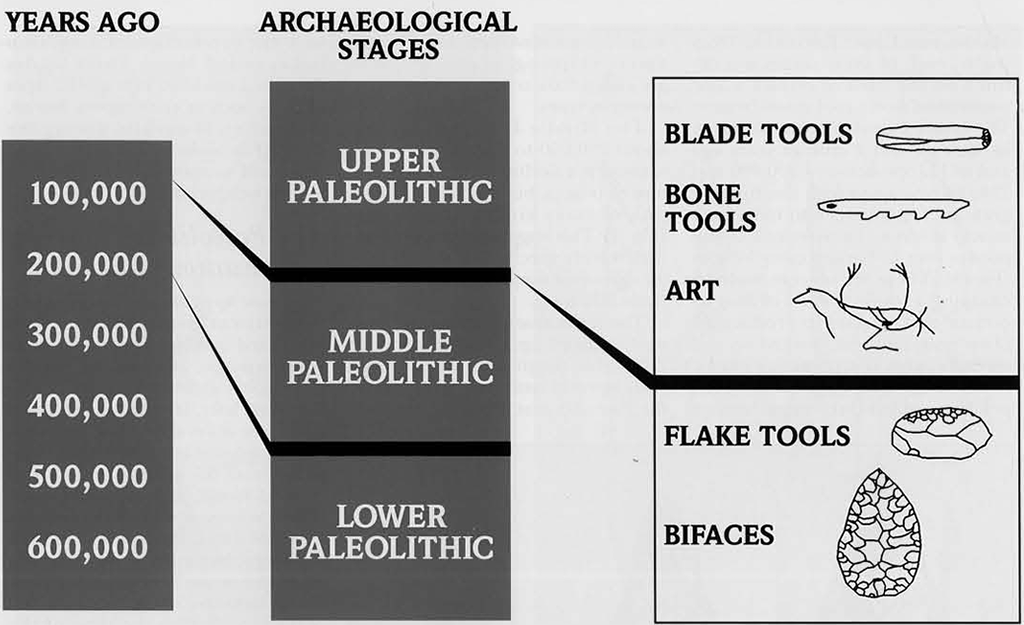
The Middle Paleolithic (from about 200,000 to 40,000 years ago) witnessed a decline in the manufacture of bifaces, but a greater elaboration of many kinds of flake tools (Fig. 4). This stage is sometimes associated with specialized techniques for manufacturing those flakes to be made into tools.
The techniques of flake manufacture changed again with the Upper Paleolithic (beginning about 40,000 years ago and lasting until the end of the Paleolithic at 10,000 years ago), with the production of long, thin flakes called blades. These blades were then modified into special types (Fig. 5), such as endscrapers, burins, and knives. It was also during the Upper Paleolithic that the first bone tools and weapons and the first art objects were produced.
The Paleolithic Colonization of Europe
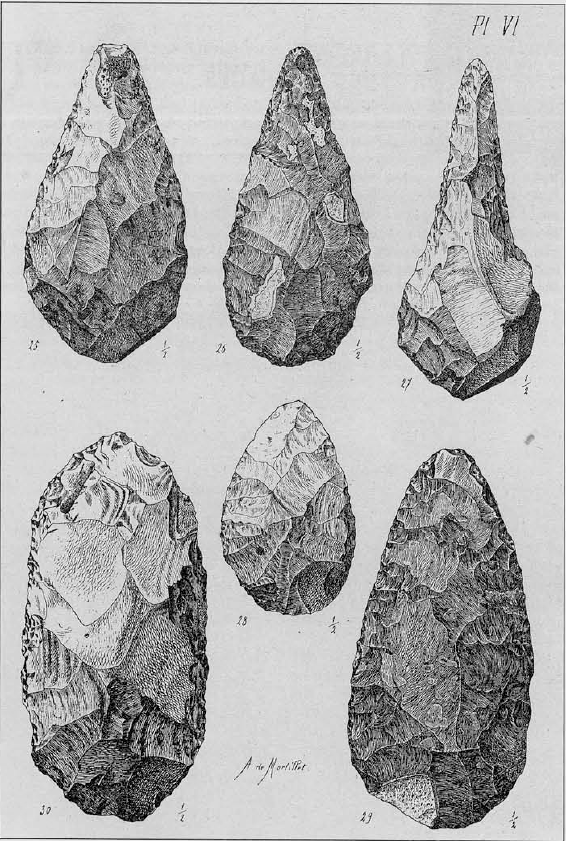
It now appears virtually certain that our earliest direct ancestors originated in Africa about 3 to 4 million years ago, and that the earliest stone tools appeared around a million years later. It was probably about 1 million years after that when hominids actually left Africa and began to colonize the other continents of the Old World, including temperate zones. Some controversial sites in Europe are dated to around 1 million years ago, but more solid estimates place the initial European colonization at between 500,000 and 750,000 years ago, during the time of the Lower Paleolithic. Of course, entry into the New World did not take place until much later, possibly as late as 12,000 years ago.
Beyond the historical importance of this initial migration out of Africa, many scholars see in it some important implications for early human behavior. First, because hominids originally evolved in sub-Saharan Africa, human adaptation to the harsher climate of Ice Age Europe suggests a significant increase in the dependency on tools and other technologies, especially the use of fire. Infact, there is evidence of controlled fire in a few very early sites in Europe. Second, as pointed out by Ward Goodenough (1990) of the University of Pennsylvania, the more dramatic seasonal fluctuations of temperate zones, especially in areas of winter snow cover, necessitate more preparation and planning than is true in tropical zones, and this may have provided some impetus for the further development of vocal communication and more complex social organization.
However, other than the use of fire, there is little evidence before the Upper Paleolithic of any specialized cold-adapted technologies. There are only some suggestions, most rather dubious, of huts or other structures in the Lower and Middle Paleolithic. Later, in the Upper Paleolithic, such features become much more common. There are examples of huts from Eastern Europe, dated to approximately 25,000 years ago, that are quite elaborate, with foundations built of interlocking jaws of woolly mammoths (Fig. 6). At many other Upper Paleolithic sites the outlines of huts can be seen by observing the distribution of artifacts. The first bone needles are from the Solutrean period of the Upper Paleolithic (about 20,000 years ago), possibly indicating the production of tailored clothing, which is another important advantage in cold climates (see Fig. 13 in Chase’s “What Were the Ice Ages?”). This does not mean that earlier hominids did not have any clothing, since they may have worn loose skins. (At one Mousterian site in France the toe bones of a fox were found together, possibly indicating that the feet were removed along with the skin.) On the other hand, these early hominids may have had more physical adaptations to cold climates, which is suggested by some aspects of their skeletal anatomy, and they may simply have had much more body hair than modern humans. Given the problems of preservation, we may never know.
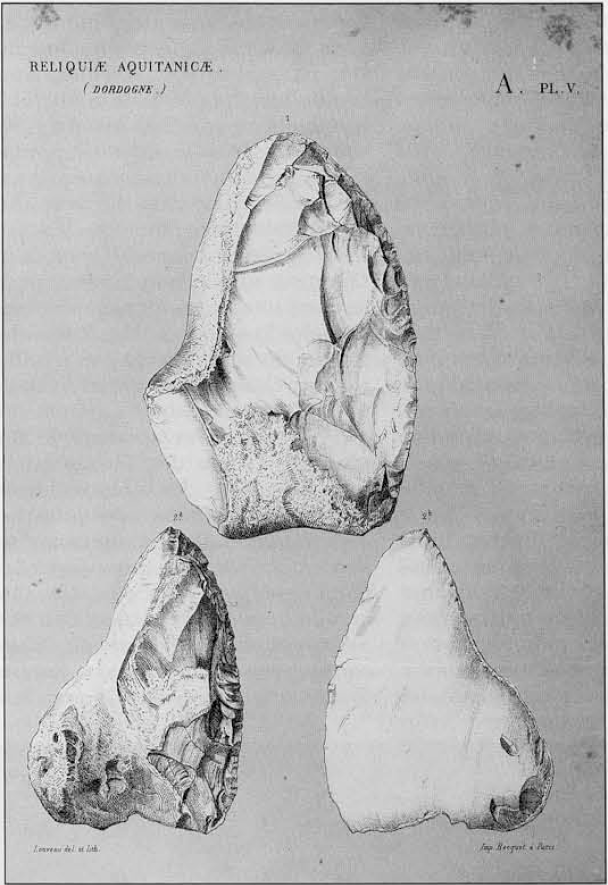
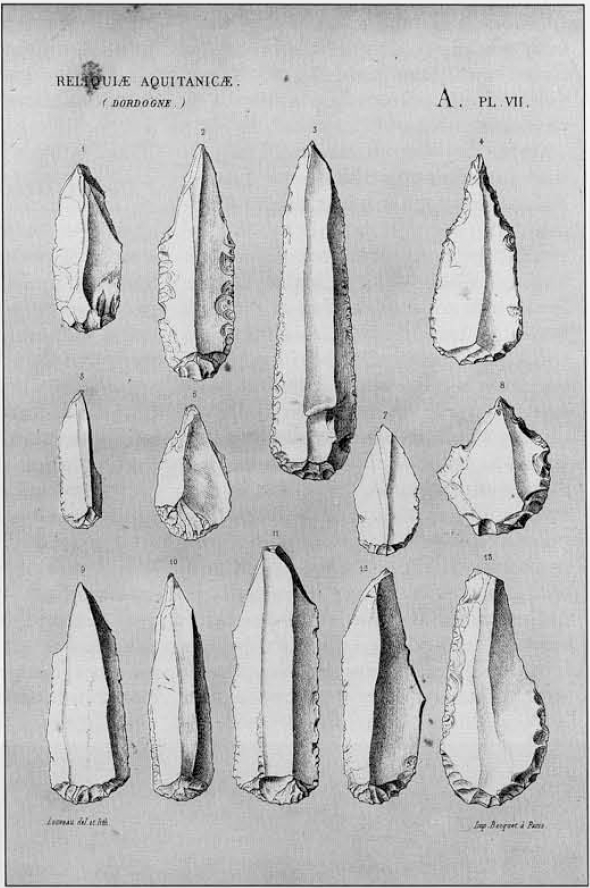
Whether or not this early migration into Europe during the Lower Paleolithic was the last such movement during the Paleolithic is currently the subject of considerable debate. While some scholars argue for continuous evolution in Europe from the Lower Paleolithic through the Upper, many lines of evidence suggest a second major influx of people (possibly from the Near East) during the transition to the Upper Paleolithic. At this time a fairly abrupt physical change occurs in the hominids, as Neanderthals are replaced by modern Homo sapiens, and the new artifacts of the Upper Paleolithic are quite different from those of the earlier Mousterian. One of the early periods of the Upper Paleolithic, the Chatelperronian, may represent a period of contact between Neanderthals and incoming modern humans. Nancy Minugh-Purvis’s article discusses some of these issues in relation to the fossil hominids themselves.
Paleolithic Technologies
Stone tools represent our major source of evidence for Paleolithic behavior. The fact that they are so well preserved, coupled with the enormous span of time during which they were produced, results in an almost staggering amount of potentially recoverable data. Imagine, for example, that during the time of the Lower Paleolithic in Europe, which may have lasted for about 500,000 years, there was a constant population of 5,000 active tool makers. Imagine also that each of these artisans made only 10 bifaces per year and perhaps 100 flake tools. These are very small numbers given that modern flintknappers can produce a biface in less than ten minutes and a flake tool in only a couple of seconds. But, even with such conservative parameters, this would have resulted in the production of 25 billion bifaces and 250 billion flake tools, of which less than one one-thousandth of one percent have been collected during the entire history of Paleolithic research.
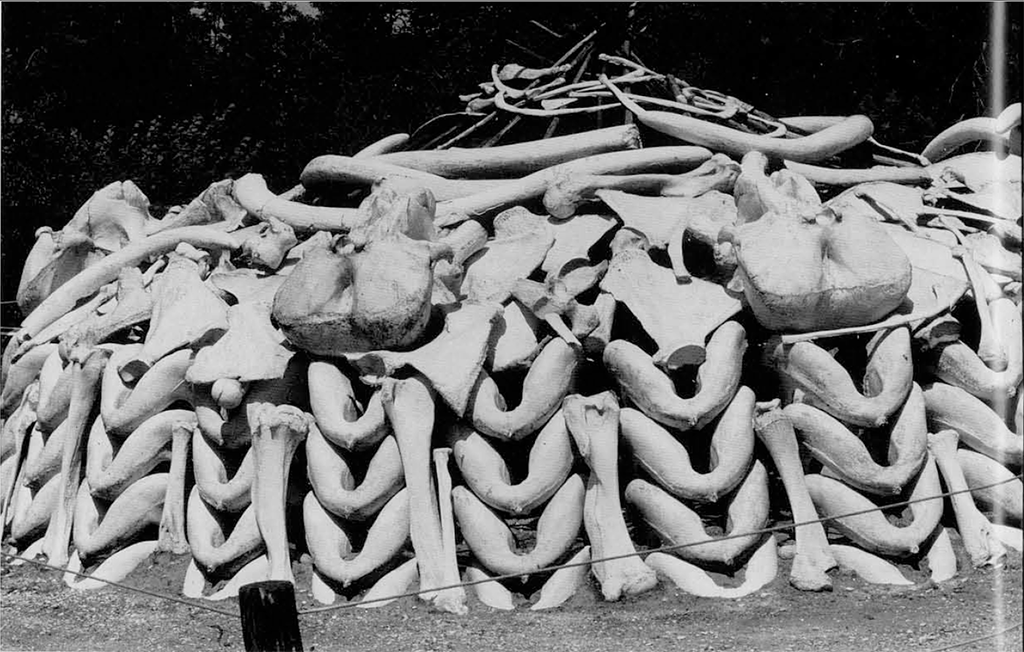
In spite of the wealth of data, there still remain rather severe problems of interpretation. Stone technologies like those of the Paleolithic simply do not exist any more. Because archaeologists therefore have no analogies on which to draw, it is difficult for them to interpret this material accurately. This is not as great a problem for other technologies. For example, we can interpret ceramic assemblages because we know from our own experience, or from studying other peoples, that certain ceramic forms function best as storage containers, serving dishes, cooking vessels, and the like. But, for the most part, we have no idea how certain Paleolithic tools were used and, in fact, archaeologists have even had to reinvent for themselves techniques for manufacturing stone tools. Whether these were the same techniques used by Paleolithic peoples is open to serious question.
Furthermore, the traditional tool types that archaeologists have defined for analyzing Paleolithic assemblages simply reflect guesses as to their real functions (like the types called scrapers, knives, and projectile points), or evoke resemblances to familiar shapes in vegetation (like the Solutrean types called “Laurel leaves” and “Willow leaves”) or animals (shark’s tooth bifaces and tools called slugs, for example).
The second problem with stone tools, and it is again something that distinguishes them from the products of other technologies, is that they are continuously subject to modification. A flake is made by striking a large flint nodule with a hammer of stone or other hard material. It can, without any other modification, be used as an effective cutting tool. But many flakes show further modification resulting from striking the edge with a piece of bone or antler, thus removing small chips in a process called retouch. If a flake is retouched again along the same edge in order to resharpen it, then the traces of the original retouch are removed. This presents a problem for archaeologists in that a single flake can be retouched over and over again, each time removing traces of former retouch and changing the overall shape of the tool, often dramatically (see Fig. 6 in Chase’s “Language in the Ice Ages”). This process can continue even after the piece is discarded, since until the piece is completely buried and hidden from view, there is nothing to prevent someone from picking it up and retouching it further. Even after it is buried, many different post-depositional processes, such as trampling and soil movement, can produce damage on the flake that looks like deliberate retouch.
Because lithic artifacts can be reused and remodified several times, they are never really “finished” until, as I like to say, they are stored safely on a museum shelf. Thus, in general, the stone tools that we find in the archaeological record simply reflect how much they were used until they were discarded, rather than what the person who made them had in mind when they were being made. In other words, while ceramics and many other artifacts most often represent intended end products, stone tools most often represent worn-out and no longer desired waste. The degree of use exhibited on retouched lithics often hides, or literally removes, many of the features that would indicate different styles or functions.
This new understanding of the dynamic properties of stone tools has led to a major revision in the interpretation of many of the types of stone tools found in Lower and Middle Paleolithic contexts. For example, for many years it has been debated whether different Mousterian assemblages, defined in terms of the frequencies of various types of tools, reflect the presence of different culture groups (Borders 1973) or whether they reflect different activities carried out at separate sites (Bin-ford and Binford 1969). In a major reinterpretation, based on our new understanding of tool use, the various assemblages have been shown to reflect little more than points on a continuum of less to more intense use and modification of the stone tools (Rolland and Dibble 1990). In other words, there are no culture groups represented—just assemblages that were more intensely reused and reworked than others.
In certain Upper Paleolithic cultures, by about 20,000 years ago, stone tool manufacture became very sophisticated and many new techniques were invented. Some forms can be replicated by only the best modern flintknappers. The fact that most of the diagnostic tool types that define each of the Upper Paleolithic cultures do show discrete geographic and temporal patterns suggests a change from the preceding Mousterian.
Tools made in materials other than stone are rare, especially in the Lower and Middle Paleolithic. Two wooden spear tips have been found in European Lower and Middle Paleolithic sites, which is extraordinary considering the problems of preservation. Bone tools are also rare before the Upper Paleolithic, but this is not a function of preservation since unworked animal remains occur frequently in Lower and Middle Paleolithic sites. In those cases where bone was worked during the earlier periods, it was chipped, or retouched, exactly as if the piece of bone were a flint flake. By the Upper Paleolithic, bone-working technology is much more widespread and utilizes techniques, such as shaving and carving, which take advantage of the material’s own properties (Fig. 7). Examples of bone tools include fishing harpoons (Fig. 8), spear throwers, needles, and items of personal adornment.
Paleolithic Economy
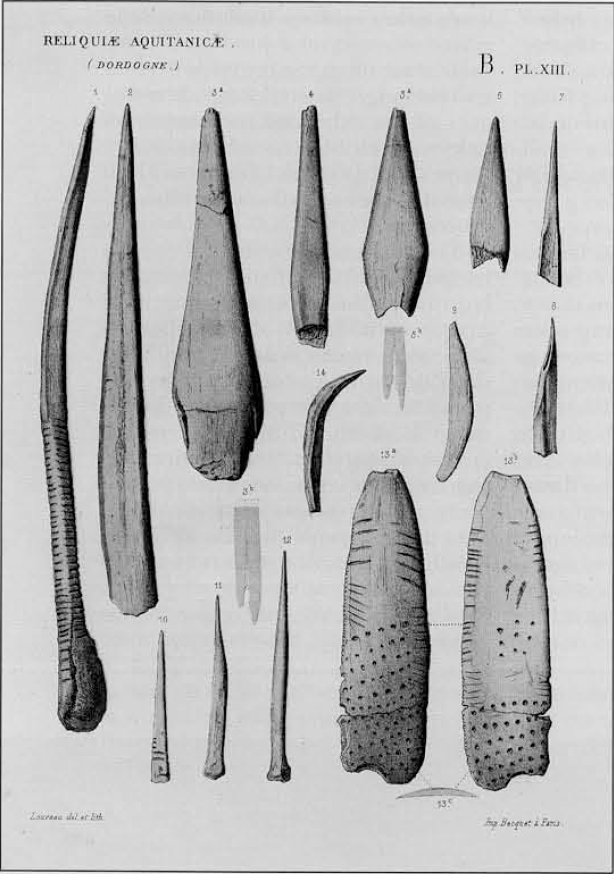
The economy of Paleolithic hunter-gatherers was very simple, with no evidence of craft specialization (though perhaps some flintknappers were better than others) or of markets. This does not mean that they were always faced with the threat of starvation or that they worked especially hard at making a living. We know from studies of modern hunter-gatherer groups, such as the Kung of the Kalahari, that adults can spend as little as ten hours per week in direct subsistence activities—in fact, one anthropologist (Sahlins 1968) has referred to hunter-gatherer groups as the world’s first affluent society! And bear in mind that these modern groups live in relatively marginal environments, having been effectively pushed off the most productive lands by agriculturalists and pastoralists. Paleolithic Europe, on the other hand, even at the height of the Ice Age, was absolutely teeming with fish and game.
Actually, the characterization of Paleolithic peoples as hunter-gatherers is more of an assumption than demonstrable fact. The gatherer part is especially hard to prove, since vegetal remains are rarely preserved in archaeological sites. Thus, it is impossible to calculate the percentage contribution that plants made to the Paleolithic diet. Animal bones are preserved in many sites, and a significant percentage of them exhibit cutmarks or other evidence of butchery and consumption. However, a controversy has recently developed over whether people actually hunted animals in the Lower and Middle Paleolithic, or simply scavenged already dead animals.
It has recently become apparent that carnivores, including lions, wolves, and hyenas, occupied many of the same sites as did humans. Furthermore, some of the characteristics of the faunal assemblages, including the age distributions of the prey and relative frequencies of particular skeletal parts, sometimes either match what is found at carnivore kill or den sites, or represent those parts most likely to be scavenged from carnivore kills. Many of the animal bones, even some of the hominid fossils themselves, show evidence of gnawing by carnivores. Thus, it is reasonable to ask whether carnivores were responsible for the original killing of the prey species, and hominids just showed up later to take advantage of them. Many of the proponents of this view also argue that the technology of the time was not sufficient for hunting large game.
On the other hand, Phil Chase, an authority on Paleolithic hunting and butchery, points out that the percentages of different species represented at these sites rarely reflects a more-or-less random assortment of available prey (1988). In fact, some Middle Paleolithic sites present a fairly concentrated selection of certain species, a pattern that indicates active hunting rather than scavenging. There are many logical arguments in favor of human hunting as well. First, our closest primate relatives, including chimpanzees and baboons, hunt small game regularly, so it is not unreasonable to suppose that such behaviors were a part of the hominid repertoire. Second, scavenging of meat that has been exposed for a very long time requires special adaptations in the digestive system (because rotten flesh contains certain toxin), Such adaptations do not exist in either modern humans or other closely related primates. And third, it is difficult to accept the argument that hominids were incapable of killing prey species but were able to compete directly with the much more dangerous carnivore species they scavenged from.
By the time of the Upper Paleolithic, especially the later Upper Paleolithic, there is clearer evidence of specialized hunting, including large-scale animal drives. Some cave drawings have been interpreted as hunting scenes, those, for example, depicting either wounded animals or animals associated with apparent projectiles, such as spears. There is also evidence that Upper Paleolithic peoples were relying on new sorts of food resources, especially fish (such as salmon) and marine shellfish.
The Origin of Modern Humans and Culture

A number of dramatic changes took place between the Middle and Upper Paleolithic in Europe. Some of these have to do with technology, including new techniques of stone tool manufacture and many new tool forms, the introduction of bone tools, and clear evidence of architecture. Subsistence strategies may also have changed. But probably the most dramatic change that took place, which is discussed in more detail by Randall White in this issue, was the introduction of art in many forms, including decorated tools and weapons, items of personal adornment, engraved and painted cave walls, and figurines carved in bone or modeled in clay. It was at this time that fully modern Homo sapiens appeared and the Neanderthal populations disappeared (see MinughPurvis’s article, this issue).
A major problem for both archaeologists and physical anthropologists has been to assess the meaning and significance of these changes. Some scholars believe that neither the physical differences between Neanderthals and modern Homo sapiens nor the behavioral differences of the two between the Middle and Upper Paleolithic reflect anything but local adaptations to their environment; in other words, there was a local evolutionary continuity in both biology and behavior. Others, however, see the behavioral changes evident in the Upper Paleolithic in Europe as being brought in by newly arriving modern Homo sapiens around 35,000 to 40,000 years ago. More importantly, many of them see these new behaviors as representing, for the first time in Europe, fully modern cultural behavior. That is, they argue that the preceding Neanderthals expressed a sort of primitive “paleoculture,” lacking complex symbolic communication and expression. Thus, the new behavior would represent not only a different adaptation, but an entirely new way of adapting.
It is virtually an axiom of cultural anthropology today that modern human cultures are adapted to a wide range of environments, including natural, social, economic, and technological conditions. One of the great differences between humans and other animals is that we adapt primarily by changing our culture, i.e., our learned behaviors and technologies, rather than by relying on genetic physical evolution (although slight physical adaptations may also occur). Thus, much of modern human cultural variation is explained in terms of such adaptations. A corollary of this view is that it is incorrect to attempt any sort of evolutionary ranking of modern human societies because any culture, no matter how primitive technologically, represents a successful adaptation to particular conditions. Of course, two human cultures with the same adaptation may exhibit quite a few differences due to their separate histories, what archaeologists generally call stylistic differences. Some archaeologists and physical anthropologists view the differences between the Middle and Upper Paleolithic, and between Neanderthals and modern Homo sapiens as slightly different adaptations to the changing environment, or to technological advances.
But another aspect of modern cultural anthropology concerns the role of language and symbols, both of which are essential in the transmission of culture to each generation and the maintenance of cultural identity. In fact, many cultural anthropologists view language, which is in itself composed of symbols, as being analogous, indeed almost synonymous, with culture itself. Thus, the question of when language and the extensive use of symbols began is an important one for determining when modern culture first developed. It is largely on the basis of a lack of clear evidence for either language or symbolic behavior in the Middle Paleolithic that some argue that the succeeding Upper Paleolithic represents a significant change, namely in the development of fully modern culture. This is the context in which Phil Chase and Randall White discuss the origins of language and art later in this issue.
Conclusions
What we currently know about European Paleolithic prehistory is only the barest of outlines and much more work will be needed to address some of the basic questions being asked about how and why humans evolved during the Ice Ages. But, as I have tried to show here, even to reconstruct the most basic aspects of Paleolithic life is very difficult and often controversial, In large part, this is a problem that stems from the nature of the data and the enormous spans of time with which we are dealing. While these problems are frustrating, they challenge us to deal with what data are available in the most creative ways possible, integrating the efforts of many different research specialties while maintaining strict scientific rigor.
Is there a payoff for all of this effort? To be honest, it is always difficult to justify archaeology in the face of all of the political, economic, and social problems currently facing us. But we need to understand our heritage, to know who we are and from where we came. The Paleolithic makes tip a surprisingly large part of that heritage. Assume for the moment that hominids first entered Europe exactly 720,000 years ago. With that somewhat arbitrary date, we can construct a time Line based on a yardstick, from the beginning of the Paleolithic to the present, where each inch represents exactly 20,000 years. Given that the Paleolithic ended 10,000 years ago, its duration is represented by the first 35 and 1/2 inches of the yardstick. The first cities began only about 1/4 of an inch ago, and the Christian era started only 1/10 of an inch ago. So, while many things that we take for granted in our current lives have developed since the Paleolithic, there is no question that, in evolutionary terms, it represents virtually all of our human heritage; it was the time when we became human. If we are ever going to understand what we are today, we have to understand those evolutionary forces that shaped us biologically and behaviorally. That is the role of Paleolithic archaeology.
